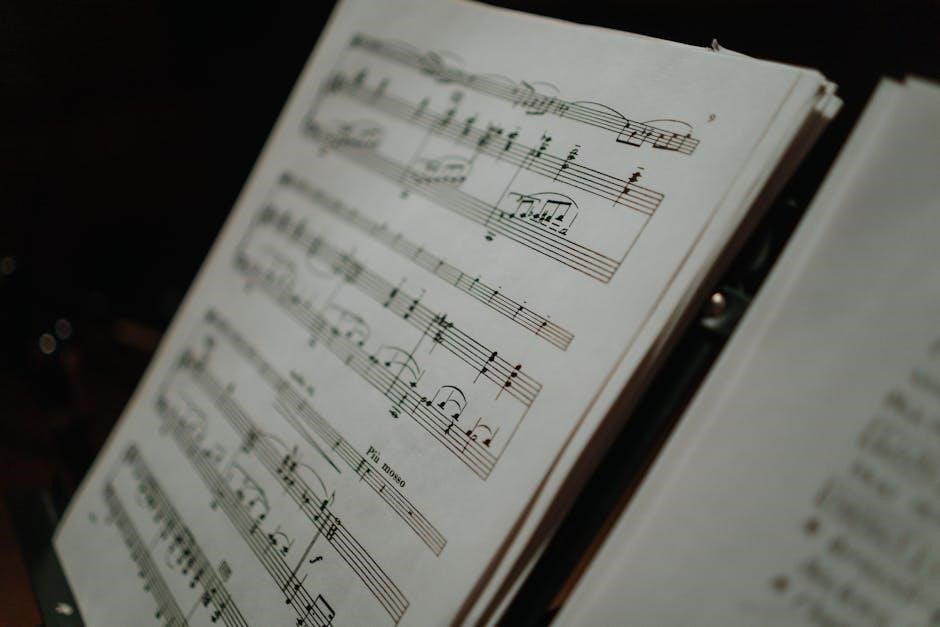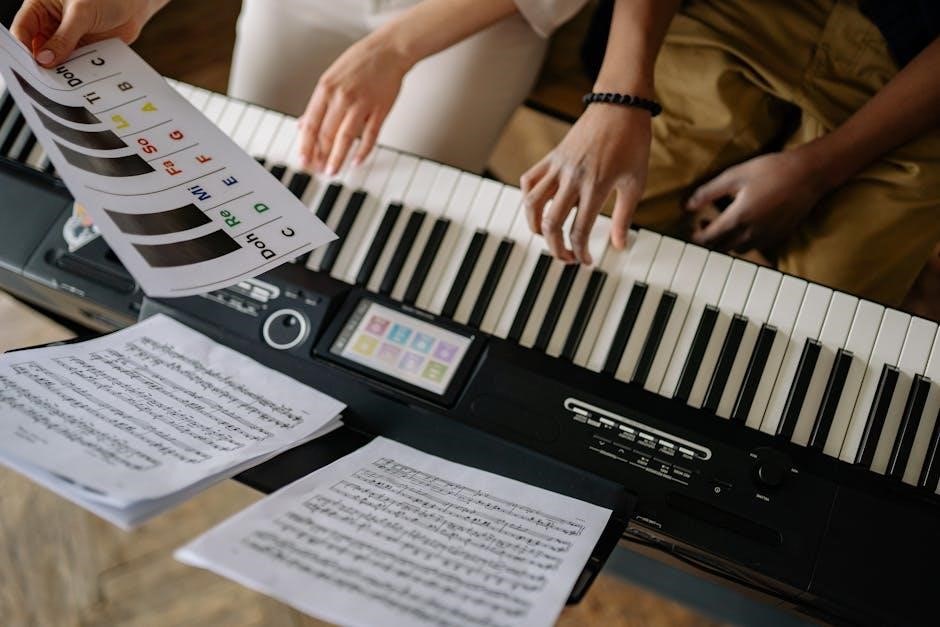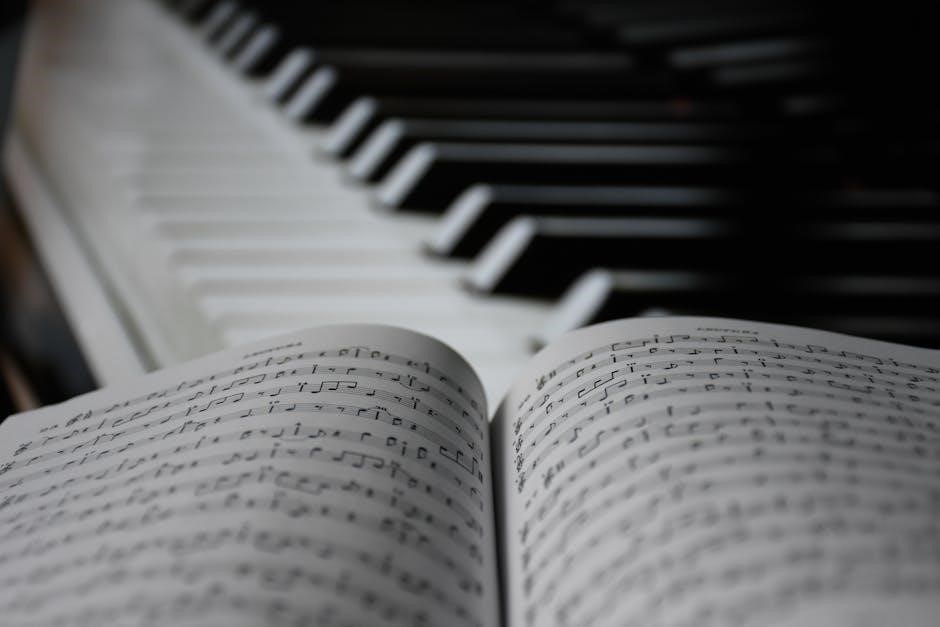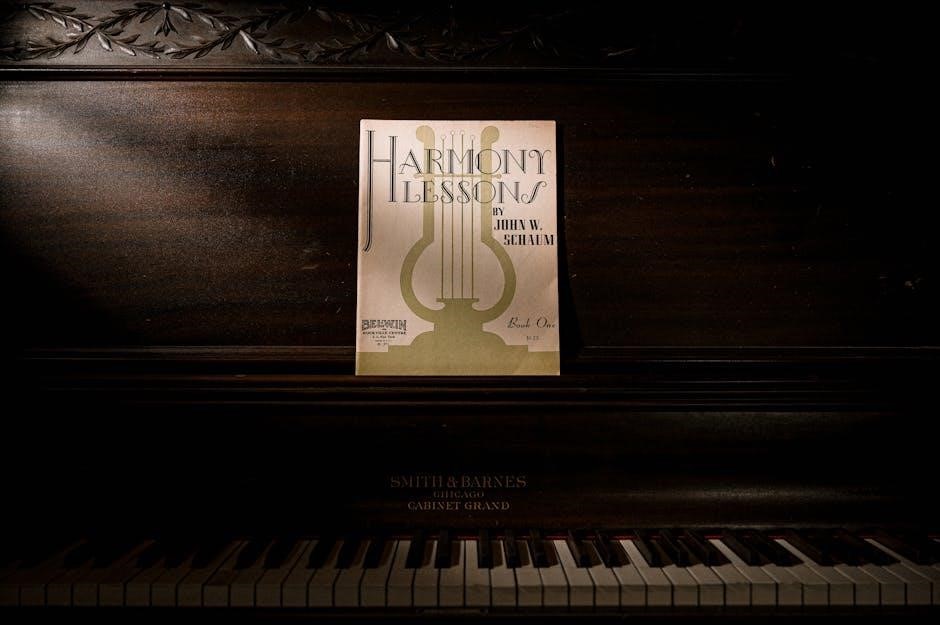Leonard Cohen’s “Hallelujah” is a timeless classic, widely celebrated for its emotional depth and poetic lyrics. Its piano arrangements are popular among pianists of all skill levels, offering a beautiful blend of simplicity and complexity. The song’s versatility has led to numerous adaptations, making it a favorite for both beginners and professionals. Its enduring appeal lies in its ability to evoke powerful emotions, connecting deeply with listeners worldwide.
1.1 Significance of the Song
Leonard Cohen’s “Hallelujah” is a timeless masterpiece, revered for its profound emotional resonance and poetic depth. Its universal themes of love, spirituality, and human connection transcend generations. The song’s adaptability has led to countless interpretations, from intimate piano solos to grand orchestral arrangements. Its complexity, combined with simplicity, makes it a favorite among pianists of all levels. Whether performed by professionals or beginners, “Hallelujah” remains a cornerstone of musical expression, offering a deeply personal and transformative experience for both players and listeners alike.
1.2 Popularity Among Pianists
“Hallelujah” has become a beloved choice among pianists due to its emotional depth and versatility. The song’s hauntingly beautiful melody, paired with its rich harmonic structure, makes it a rewarding piece to play. Pianists of all skill levels seek out “Hallelujah” piano sheet PDFs, as they offer both personal enjoyment and performance opportunities. Its adaptability to various styles, from classical to contemporary, further enhances its appeal, making it a staple in many pianists’ repertoires. The song’s enduring popularity ensures its continued relevance in piano culture.

Understanding the Sheet Music
Understanding the sheet music involves analyzing the structure, notation, and dynamics. It requires interpreting tempo, musical expressions, and emotional depth to capture the song’s essence accurately;
2.1 Structure and Composition
The piano sheet music for “Hallelujah” typically follows a verse-chorus structure, with intricate chord progressions and arpeggios. The composition often includes modulation between keys, adding emotional depth. Pianists must pay attention to dynamics, tempo changes, and expressive markings to capture the song’s haunting beauty. The sheet music may also feature complex harmonies and melodic variations, reflecting the song’s poetic and spiritual essence. Understanding the interplay between melody and accompaniment is crucial for an authentic performance.
2.2 Key, Tempo, and Dynamics
The piano sheet music for “Hallelujah” is typically in the key of C Major, with frequent modulation to A Minor, creating emotional depth. The tempo is slow and reflective, usually around 66 BPM, which suits the song’s melancholic nature. Dynamics play a crucial role, starting softly (pianissimo) in verses and building to dramatic crescendos (mezzo-forte to forte) in choruses. Paying attention to these elements is essential for capturing the song’s emotional journey and delivering an expressive performance.

Sources for Downloading
Piano sheets for “Hallelujah” are available on official sites like Musicnotes and Sheet Music Plus, as well as free platforms like MuseScore and Piano Nanny.
3.1 Official Websites and Marketplaces
Official websites like Musicnotes and Sheet Music Plus offer high-quality “Hallelujah” piano sheet music. These platforms provide legally licensed PDF downloads, ensuring authenticity and quality. They cater to various skill levels, from beginner to advanced, and often include annotations for better understanding. Purchasing from these sites supports the artists and composers, making them a reliable choice for enthusiasts. Additionally, many marketplaces allow previews, enabling users to assess the difficulty and arrangement before downloading.
3.2 Free Resources and Communities
Free piano sheet music for “Hallelujah” can be found on platforms like MuseScore and Piano Nanny, where users share arrangements. These websites often provide PDF downloads without cost, making them accessible to everyone. Online forums and communities, such as Scribd or Reddit, also host shared resources. While some sheets may lack professional polish, they offer a great starting point for learners. Many creators share their interpretations, allowing pianists to explore diverse arrangements of the song.

Arrangements Available
The piano sheet music for “Hallelujah” is available in various arrangements, catering to different skill levels and preferences. These include simplified versions, complex interpretations, and adaptations for both piano and vocal performances.
4.1 Original vs. Covers
The original piano sheet music for “Hallelujah” mirrors Leonard Cohen’s iconic composition, offering a timeless interpretation. Covers, however, provide fresh perspectives, often blending piano with other instruments or vocals. Some arrangements enhance dynamics, while others simplify complexity for accessibility. Pianists can choose between staying true to Cohen’s vision or exploring creative reinterpretations, depending on their style and skill level. This versatility ensures “Hallelujah” remains a beloved piece for both purists and innovators, allowing for personal expression while maintaining the song’s emotional core.
4.2 Instrumental vs. Vocal
The “Hallelujah” piano sheet music is available in both instrumental and vocal arrangements, catering to different preferences. Instrumental versions focus solely on the piano melody and harmonies, emphasizing the song’s emotional depth through music alone. Vocal arrangements include lyrics, often blending piano accompaniment with singing, which adds another layer of expression. Pianists can choose based on their performance goals, whether showcasing musicality or storytelling through lyrics. Both versions highlight the song’s versatility, making it accessible for various interpretations and performances.

Difficulty Levels
The “Hallelujah” piano sheet music offers varying difficulty levels, making it accessible to pianists of all skill levels, from beginners to advanced players seeking a challenge.
5.1 Beginner-Friendly Sheets
Beginner-friendly “Hallelujah” piano sheets simplify the iconic song’s complexity, focusing on basic chord progressions and melodies. These arrangements avoid intricate fingerings and advanced techniques, making them accessible to new pianists. They often include simplified harmonies and slower tempos, allowing learners to build confidence and master foundational skills. Many resources offer step-by-step guides or stripped-down versions, ensuring a smooth learning curve. These sheets are ideal for those looking to grasp the song’s essence without overwhelming technical demands, providing a solid starting point for further exploration.
5.2 Advanced and Professional Arrangements
Advanced and professional arrangements of “Hallelujah” offer intricate details for skilled pianists, featuring complex harmonies, arpeggios, and dynamic contrasts. These sheets often include nuanced expressions, ornamentations, and challenging fingerings that bring out the song’s emotional depth. They cater to pianists seeking to showcase technical mastery and artistic interpretation. Many professional versions incorporate extended techniques or original improvisations, making them suitable for performers aiming to deliver a captivating and polished rendition of this timeless classic.

Learning Tools and Resources
Discover software like MuseScore for editing and apps like Fender Play for guided practice. Online platforms offer tutorials, community support, and real-time feedback for pianists everywhere.
6.1 Software for Viewing and Editing
Utilize software like MuseScore or Adobe Acrobat to view and edit “Hallelujah” piano sheet PDFs. These tools allow annotation, tempo adjustment, and conversion to other formats. FL Studio and Logic Pro can import MIDI files for further arrangement. PDFelement enables direct editing of PDF sheets, while MuseScore supports customizing notes and dynamics. These resources are essential for pianists aiming to personalize or adapt the sheet music to their skill level or performance style, ensuring a tailored learning experience.
6.2 Apps and Online Platforms
Explore apps like Piano Maestro and Fender Play for interactive learning of “Hallelujah” piano sheets. Online platforms such as Scribd and Musicnotes offer extensive libraries of sheet music, including “Hallelujah.” Apps like ForScore and Sheet Music Plus provide features for annotating and organizing your sheets. These tools enhance accessibility and organization, making it easier to learn and perform the piece. They are ideal for pianists seeking convenience and additional learning resources.

Practice Techniques
Master “Hallelujah” with slow practice, focusing on chord progressions and arpeggios; Use a metronome to build rhythm and timing. Practice hands separately before combining them for seamless performance.
7.1 Breaking Down Complex Sections
Breaking down complex sections of “Hallelujah” allows pianists to tackle challenging parts effectively. Identify difficult passages, such as intricate arpeggios or dynamic shifts, and practice them in isolation. Start with a slow tempo to build accuracy, then gradually increase speed. Focus on transitions between sections to ensure smoothness. Repeat each segment multiple times to develop muscle memory. Pay attention to dynamics and expression, as these elements are crucial for conveying emotion. Use tools like a metronome or practice software with loop functions to refine tricky areas. Consistent, focused practice will help mastery of the piece.
7.2 Using Technology for Better Practice
Technology can significantly enhance your practice of “Hallelujah.” Use software like MIDI editors or digital audio workstations to slow down or loop challenging sections. Apps such as Synthesia or Piano Nanny offer interactive lessons and exercises tailored to your needs. Online platforms provide access to tutorials, allowing you to refine specific techniques. Record yourself to track progress and identify areas for improvement. Utilize metronomes for tempo accuracy and explore tools that visualize sheet music, making complex passages easier to interpret. These resources empower you to practice efficiently and effectively.

Community and Support
Engaging with online forums, piano groups, and workshops fosters growth and motivation. Collaborate with fellow pianists, share tips, and gain insights to refine your “Hallelujah” performance.
8.1 Online Forums and Groups
Online forums and groups dedicated to piano enthusiasts are invaluable for “Hallelujah” learners. Platforms like Piano World, Reddit’s r/piano, and Facebook groups offer a space to share experiences, ask questions, and receive feedback. Many members share their interpretations of the song, providing inspiration and diverse perspectives. These communities also host discussions on technique, sheet music recommendations, and practice strategies. Engaging with fellow pianists fosters motivation and accountability, creating a supportive environment to refine your skills and master the emotional depth of “Hallelujah.”
8.2 Workshops and Tutorials
Workshops and tutorials are excellent resources for mastering “Hallelujah” on the piano. Online platforms like YouTube, Udemy, and Skillshare offer step-by-step lessons tailored to various skill levels. Many piano teachers provide video tutorials, breaking down the song’s complexities into manageable parts. Additionally, websites like Piano Nanny and HDpiano feature detailed breakdowns of the melody, chord progressions, and emotional expression. These resources often include downloadable PDF sheets, making it easier to follow along and practice effectively. They cater to both beginners and advanced players, ensuring a comprehensive learning experience.

Performance Tips
Mastering “Hallelujah” on piano requires emotional depth and technical precision. Focus on dynamics, tempo, and expression to convey the song’s haunting beauty. Maintain good posture, engage with the audience, and practice mindfulness to enhance your performance quality and connection with the music.
9.1 Stage Presence and Expression
Stage presence and expression are crucial when performing “Hallelujah” on piano. Maintain confident posture, engage with the audience through eye contact, and use facial expressions to convey emotion. Ensure your body language reflects the song’s intensity and vulnerability, drawing listeners into its narrative. Balance passion with restraint to honor the piece’s complexity and depth.
Experiment with dynamics and tempo to emphasize key moments, allowing the melody to breathe. Practice mindfulness to stay present and authentic during performance, ensuring a profound connection with both the music and the audience.
9.2 Handling Mistakes During Performance
When mistakes occur during a performance of “Hallelujah,” remain calm and composed. Avoid stopping or drawing attention to the error. Instead, transition smoothly to the next section, ensuring continuity. A brief pause or fermata can help regain focus without disrupting the flow.
Embrace the song’s emotional depth to overshadow minor flaws. Practice under pressure to build resilience and confidence. Remember, the audience often feels the music’s passion more than they notice technical imperfections. Learn to move forward gracefully, turning mistakes into moments of authenticity.

Cultural Impact
“Hallelujah” has transcended genres, inspiring countless covers and adaptations. Its emotional depth resonates universally, making it a timeless classic in music and popular culture.
10.1 The Song’s Journey and Evolution
“Hallelujah” was first released by Leonard Cohen in 1984 but gained widespread acclaim after Jeff Buckley’s 1994 cover. Over the years, it has evolved through numerous interpretations, becoming a timeless classic. Its poetic lyrics and haunting melody have made it a favorite for pianists, with sheet music arrangements reflecting its emotional depth. The song’s journey from obscurity to global recognition highlights its universal appeal, making it a staple in music culture and a popular choice for piano adaptations.
10.2 Influence on Other Artists and Media
Leonard Cohen’s “Hallelujah” has profoundly influenced countless artists, inspiring over 300 recorded covers. Musicians like Jeff Buckley, John Cale, and Rufus Wainwright have reimagined the song, each adding unique interpretations. Its emotional resonance has made it a staple in films, TV shows, and commercials, further cementing its cultural impact. The song’s versatility has also led to adaptations in various genres, from classical to rock, showcasing its timeless appeal and enduring legacy in music and media.
Legal Aspects
Understanding copyright and licensing is crucial when using “Hallelujah” piano sheets. Respect intellectual property rights to avoid legal issues and ensure fair use of the composition.
11.1 Copyright and Licensing
The “Hallelujah” piano sheet pdf is protected under copyright laws, requiring proper licensing for use. Ensure downloads are from authorized sources to avoid infringement. Licensing is mandatory for public performances or commercial use, with permissions typically managed by publishers or rights holders like Sony Music Entertainment. Unauthorized distribution or use can lead to legal consequences. Always verify the source and obtain necessary permissions to comply with copyright regulations and respect the rights of Leonard Cohen and his estate.
11.2 Legal Downloading and Usage
Downloading the “Hallelujah” piano sheet pdf legally ensures compliance with copyright laws. Always use official sources like Musicnotes or Sheet Music Plus, which offer licensed versions. Avoid unauthorized websites, as they may violate copyright. Even free downloads require permission for commercial use. Ensure you have the right to use the sheet music for performances or recordings. Legal usage supports artists and publishers, promoting fair compensation for their work. Verify permissions before sharing or distributing the sheet music to avoid legal issues.
Mastering “Hallelujah” on piano is a rewarding journey. With practice and dedication, pianists can bring this iconic song to life, sharing its emotional depth with audiences worldwide.
12.1 Final Thoughts and Encouragement
Embracing the “Hallelujah” piano sheet PDF is a journey of musical growth. Pianists, whether novice or seasoned, will find deep fulfillment in mastering this timeless piece. Persist through challenges, as each note tells a story; The emotional depth of “Hallelujah” resonates universally, making it a profound addition to any repertoire. Stay inspired, practice with passion, and share its beauty with others. Your dedication will shine through every performance, leaving a lasting impact on all who listen.
12.2 Continuous Learning and Improvement
Continuous learning is key to mastering the “Hallelujah” piano sheet PDF. Refine your techniques by exploring various arrangements and interpretations. Utilize online tutorials and practice software to enhance your skills. Dedication and consistent practice will lead to a deeper understanding of the piece. Embrace challenges as opportunities for growth, and remember, the journey to perfection is lifelong. By continually improving, you’ll unlock new dimensions of this timeless song, inspiring both yourself and your audience.